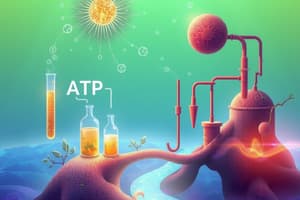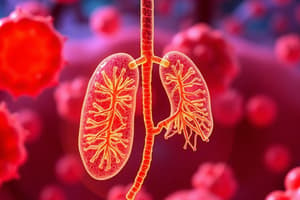Podcast
Questions and Answers
What are the products produced during anaerobic respiration in muscles?
What are the products produced during anaerobic respiration in muscles?
- ATP, pyruvic acid, lactic acid
- NAD, lactic acid, CO2 (correct)
- Oxygen, glucose, ATP
- NAD, water, glucose
How much ATP is produced per glucose during anaerobic respiration?
How much ATP is produced per glucose during anaerobic respiration?
- 4 ATP
- 5 ATP
- 1 ATP
- 2 ATP (correct)
What happens to lactic acid when oxygen becomes available again?
What happens to lactic acid when oxygen becomes available again?
- It is oxidized back to pyruvic acid (correct)
- It is converted to glucose
- It is stored in the muscles indefinitely
- It is removed from the body as waste
What process do some cells rely on when there is not enough oxygen for cellular respiration?
What process do some cells rely on when there is not enough oxygen for cellular respiration?
Why is anaerobic respiration considered less efficient?
Why is anaerobic respiration considered less efficient?
What is a consequence of lactic acid accumulation in muscles?
What is a consequence of lactic acid accumulation in muscles?
What is recycled through fermentation when cells rely on glycolysis for ATP?
What is recycled through fermentation when cells rely on glycolysis for ATP?
Which of the following is a consequence of low oxygen availability in cells?
Which of the following is a consequence of low oxygen availability in cells?
What is the primary purpose of fermentation in the context of glycolysis?
What is the primary purpose of fermentation in the context of glycolysis?
Why might cells undergo glycolysis instead of cellular respiration?
Why might cells undergo glycolysis instead of cellular respiration?
What type of fermentation occurs in muscle cells when oxygen is low?
What type of fermentation occurs in muscle cells when oxygen is low?
Which of the following organisms commonly perform ethanol fermentation?
Which of the following organisms commonly perform ethanol fermentation?
What role does pyruvate play in lactic acid fermentation?
What role does pyruvate play in lactic acid fermentation?
Which of the following statements about fermentation is true?
Which of the following statements about fermentation is true?
Which fermentation process is characteristic of yeast?
Which fermentation process is characteristic of yeast?
What is the first step in the conversion of lactate to glucose?
What is the first step in the conversion of lactate to glucose?
During the training cycle, where does glucose originate from?
During the training cycle, where does glucose originate from?
What step involves converting lactate into free glucose?
What step involves converting lactate into free glucose?
What is carried by blood back to the skeletal muscles?
What is carried by blood back to the skeletal muscles?
What happens during step 8 in the process of transforming lactate?
What happens during step 8 in the process of transforming lactate?
What physiological process occurs during rest involving glucose?
What physiological process occurs during rest involving glucose?
Which step is related to the return of glucose to muscle tissue?
Which step is related to the return of glucose to muscle tissue?
What is the role of glucose during the recovery phase for muscles?
What is the role of glucose during the recovery phase for muscles?
Which of the following is NOT a function of glucose during rest?
Which of the following is NOT a function of glucose during rest?
How does glucose return to muscle tissues according to the process outlined?
How does glucose return to muscle tissues according to the process outlined?
Flashcards are hidden until you start studying
Study Notes
Cellular Respiration & Fermentation
- When oxygen is limited, cells rely on glycolysis to produce ATP and recycle NAD+ via fermentation.
- Two main types of fermentation:
- Ethanol Fermentation: occurs in bacteria, fungi, and yeast
- Lactic Acid Fermentation: occurs in muscle cells when oxygen is low
Lactic Acid Fermentation
- Pyruvate accepts hydrogen ions (H+) from NADH, regenerating NAD+. This produces lactic acid and carbon dioxide (CO2).
- Lactic acid fermentation produces 2 ATP per glucose molecule, which is less efficient than aerobic respiration.
- When oxygen becomes available, lactic acid is oxidized back to pyruvic acid and enters the Krebs cycle.
Muscle Glycogen Restoration
- During exercise, muscle cells use glycogen as a source of glucose.
- Lactic acid generated during exercise is transported by the blood to the skeletal muscles.
- During rest, the glucose from lactic acid is used to replenish muscle glycogen stores.
Studying That Suits You
Use AI to generate personalized quizzes and flashcards to suit your learning preferences.




